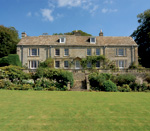Cotswold country house for sale
A well-kept secret in the Cotswolds has come onto the market for the first time in 37 years


With all eyes on the racing at Prestbury Park this week, I wonder how many well-heeled punters zipping past the Duntisbournes on the A417 between Cirencester and Cheltenham are aware that secluded Duntisbourne House exists, let alone that this best-kept of Cotswold secrets comes on the market in today s Country Life for the first time in 37 years? Throughout that period, this classic Cotswold stone house, set in 70 acres of glorious Cotswold countryside, has been the treasured country home of the distinguished banker, lawyer and former Bank of England governor Lord Richardson and his late wife, who died two years ago. The decision to sell has been an agonising one, both for Lord Richardson, now aged 93, and his children, the Hon Lady Riddell and her brother, Simon, for whom Duntisbourne House was an idyllic weekend and holiday retreat when their own children were growing up. Of course, we shall all miss this wonderful house, which has been part of our lives for so long, but at least I know that my parents were really happy there, Lady Riddell says softly. So after seven years of leisurely discussions ( mostly spent sipping tea on the terrace with Lord and Lady Richardson, talking about everything but the business in hand ), it s now down to Sam Trounson and his colleagues at Strutt & Parker (01285 653101) to find a buyer at or, more likely, above the £5 million guide price. As the first major house to come on the market in the Cotswolds this year, the interest from potential purchasers is bound to be intense. The original Duntisbourne House was built in 1760 for Sir Mark Pleydell, whose family lived at nearby Coleshill and Ampney Park, from where Sir Mark often rode out along the Frome Valley to look after his affairs. For him, its many splendid beech trees made this the golden valley , and he chose a site high on the hill looking south-west across the valley to the village of Edgeworth on the other side. The locals christened the new manor Sir Mark s Folly, and after his death, it passed to his grandson Jacob, later the Earl of Radnor. New wings were added to the house in about 1800, when it was bought by Dr Matthew Baillie, the morbid anatomist who was appointed Physician Extraordinary to George III. The next owner was his son, William Hunter Baillie, who trained as a barrister, but never practised, preferring a life as a country gentleman and squire of Duntisbourne Abbots. Following his father s death in 1823, William grew close to his aunt, the poet and dramatist Joanna Baillie, expending much time and money researching his family pedigree, and encouraging his aunt to write her memoirs. Having survived five of his eight children, William died in 1894, aged 97; the manor remained in Baillie family ownership until 1904. In the 1920s, the house was partly rebuilt by Cmdr Radcliffe James after a fire in 1922. It was again remodelled in 1971, when Lord Richardson added the present drawing-room wing to restore the balance of the original Georgian house. Such works were, no doubt, facilitated by the fact that Duntisbourne House isn t listed, although it s mentioned in Pevsner s The Buildings of England as having splendid views over the steep Frome valley . They can be seen from every main room in the house, and, in the constantly changing Cotswold light, make this a truly magical place, Lady Riddell muses. Duntisbourne House has everything a country family could dream of, including four reception rooms, a kitchen/breakfast room, a large master suite, six further bedrooms and four further bathrooms. Additional guest or staff accommodation is available in the three-bedroom lodge, or the two-bedroom stable flat. Lord Richardson s gardens are a perennial delight, and leisure amenities include stabling, a hard tennis court, a heated swimming pool and a croquet lawn the latter the scene of ferocious croquet matches involving politicians and other visiting dignitaries, Lady Sarah recalls. Amazingly, it seems that no one ever cheated.
Sign up for the Country Life Newsletter
Exquisite houses, the beauty of Nature, and how to get the most from your life, straight to your inbox.
Country Life is unlike any other magazine: the only glossy weekly on the newsstand and the only magazine that has been guest-edited by HRH The King not once, but twice. It is a celebration of modern rural life and all its diverse joys and pleasures — that was first published in Queen Victoria's Diamond Jubilee year. Our eclectic mixture of witty and informative content — from the most up-to-date property news and commentary and a coveted glimpse inside some of the UK's best houses and gardens, to gardening, the arts and interior design, written by experts in their field — still cannot be found in print or online, anywhere else.
-
 ‘It had the air of an ex-rental, and that’s putting it politely’: How an antique dealer transformed a run-down Georgian house in Chatham Dockyards
‘It had the air of an ex-rental, and that’s putting it politely’: How an antique dealer transformed a run-down Georgian house in Chatham DockyardsAn antique dealer with an eye for colour has rescued an 18th-century house from years of neglect with the help of the team at Mylands.
By Arabella Youens
-
 A home cinema, tasteful interiors and 65 acres of private parkland hidden in an unassuming lodge in Kent
A home cinema, tasteful interiors and 65 acres of private parkland hidden in an unassuming lodge in KentNorth Lodge near Tonbridge may seem relatively simple, but there is a lot more than what meets the eye.
By James Fisher